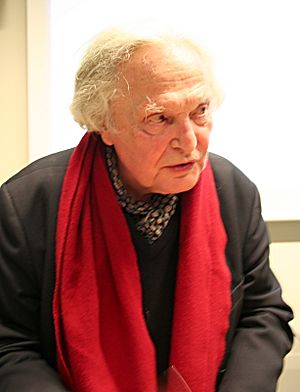Frank Popper facts for kids
Quick facts for kids
Frank Popper
|
|
|---|---|

Popper in 2006
|
|
| Born | 17 April 1918 |
| Died | 12 July 2020 (aged 102) |
| Nationality | French and British |
| Alma mater | Paris-Sorbonne University |
| Known for | Historian of art and technology |
| Scientific career | |
| Fields | Aesthetics and the science of art |
Frank Popper (born April 17, 1918 – died July 12, 2020) was a famous historian of art and technology. He was born in what is now the Czech Republic. Later, he became a French and British citizen.
Popper was a professor at the University of Paris VIII. He taught about the beauty of art (aesthetics) and the science behind it. The French government even gave him a special award called the Légion d'honneur. He wrote several important books, including Origins and Development of Kinetic Art and From Technological to Virtual Art.
Frank Popper spent much of his career studying how technology and art work together. He especially looked at art forms where people could get involved, from the late 1960s to the early 1990s.
Contents
Exploring Kinetic and Op Art
In his books, Frank Popper explained how Kinetic Art became very important. Kinetic Art uses movement to create its effect. It helped connect science, technology, art, and the world around us. Popper believed that mixing these different areas made art more human.
Popper's interest in art began in the 1950s. He met a kinetic artist named George Rickey. Rickey's work used movement and was based on scientific ideas. Popper also met other artists like Nicolas Schoffer and Frank Malina. Their art also used scientific knowledge.
How Op Art Changed Things
In the early 1960s, Op Art also greatly influenced Popper. Op Art uses optical illusions to create movement or patterns. It made people think about how they saw things. It showed that each person's view of art could be different and change.
Op Art also encouraged viewers to become more involved. They didn't just look at the art. Their own perception helped create the experience. Sometimes, they could even physically change the artwork. Popper met many Op Art artists in Paris. These meetings greatly shaped his ideas about art and its history.
The Rise of Virtual Art
Popper became very interested in art where the audience could participate. This led him to explore networking art by artists like Piotr Kowalski and Roy Ascott. Their work confirmed his ideas about audience involvement.
By the late 1980s and 1990s, new forms of art appeared. These included immersive virtual reality and digital art. Popper started to study these new artworks. He looked at artists like Shawn Brixey and Joseph Nechvatal. He saw how technology was creating new kinds of art.
What is Virtual Art?
Popper used the term virtual art for art made with new technologies from the late 1980s. These technologies included special tools like:
- Headsets that let you see images all around you.
- Glasses and screens that create 3D images.
- Speakers that make sounds seem to come from different directions.
- Gloves and suits that let you feel things in the virtual world.
These tools allowed people to feel like they were inside the art. They could also interact with it. The feeling of reality was very strong. It came from seeing, hearing, and even touching. Popper called this experience immersive virtual reality (VR).
In his 2006 book, From Technological to Virtual Art, Popper explained how this art developed. He showed that modern virtual art grew from earlier technological art. But it also brought new ideas.
What was new about this art? Popper said it made technology more human. It focused on interactivity, meaning people could control or change the art. It also explored the difference between what is real and what is virtual. Plus, it used many senses, not just sight.
Popper believed that artists who create virtual art are special. They combine their love for aesthetics (beauty in art) with their knowledge of technology. Their goals go beyond just making pretty pictures. They want to connect art with science, society, and even basic human feelings.
Defining Virtual Art
Frank Popper defined virtual art as art that lets us dive into computer art and interact with it. This happens through special technology. He found a way that art and technology could combine to create new forms of expression.
Popper looked at art from 1918 to 1983 that used light, movement, and electronics. These were early examples of virtual art. Then, he explored modern new media art. This included digital art that you could touch, offline multimedia works, interactive digital installations, and online multimedia works (net art).
Popper believed that virtual art offers a new way to think about human values in a world full of technology. He saw virtual art as more than just putting art into a new tool. It was a deep look into how these technologies affect our understanding of reality, our minds, and our environment. This mix of art and technology creates something completely new.
Other thinkers like Jack Burnham and Gene Youngblood also explored art and technology. They showed how art has become more "virtual," just as Popper described.


